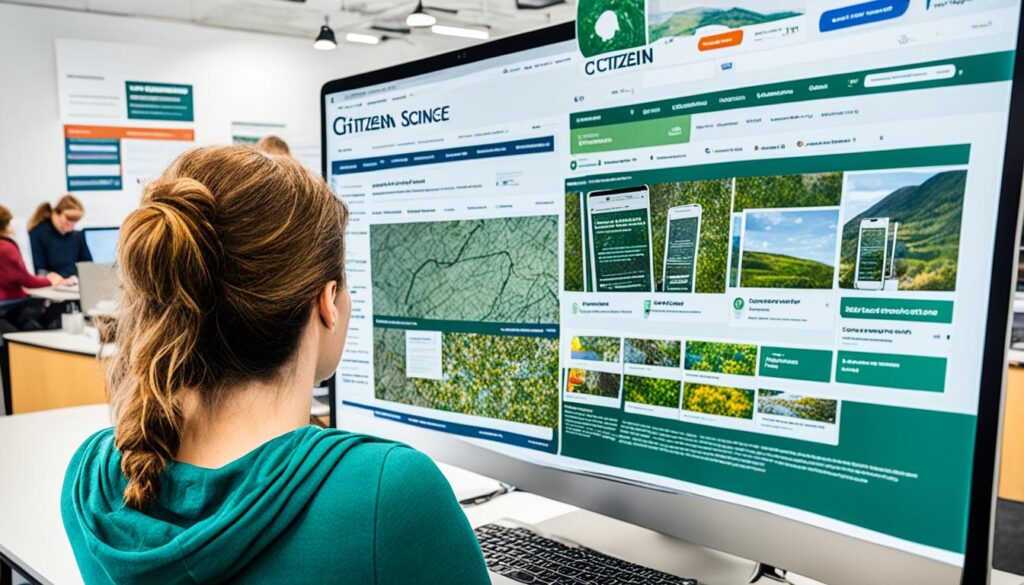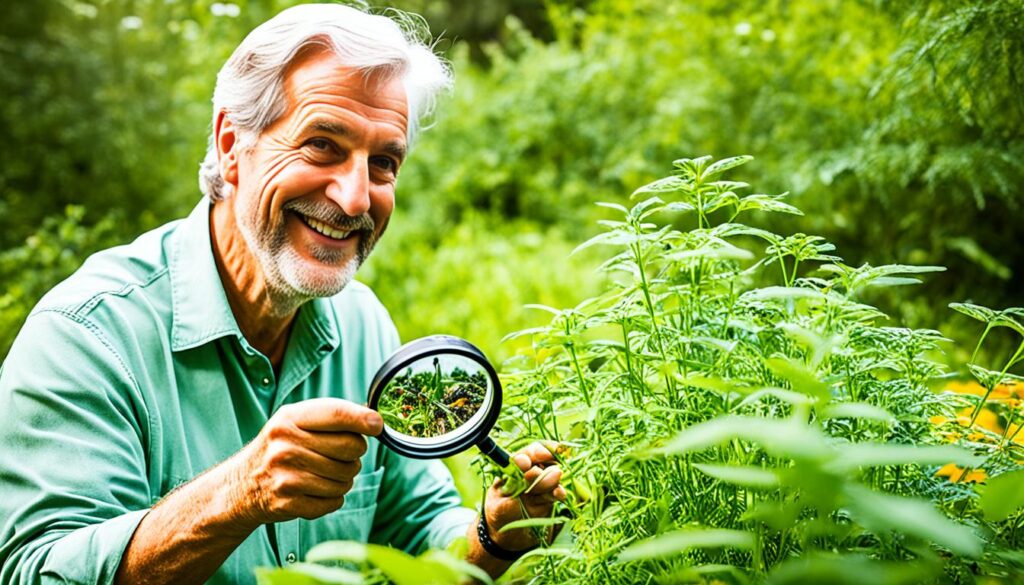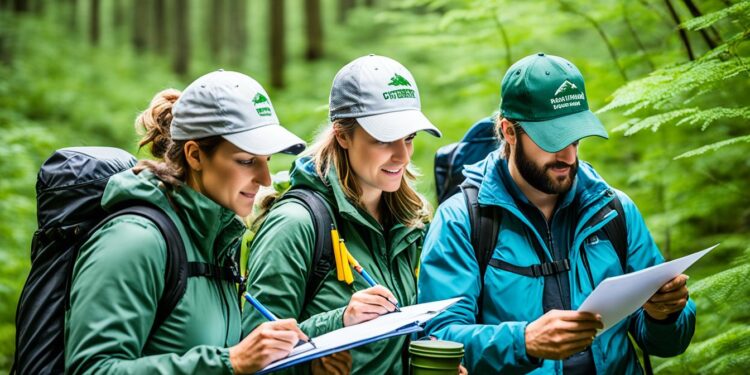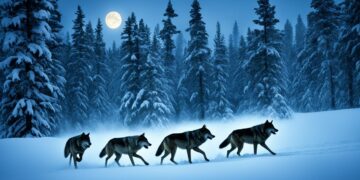Citizen science lets people help with scientific research and protect the environment. By joining these projects, you can connect more with nature, learn new things, and help the world. This guide will show you how to start your own science journey.
Citizen science projects bring people together to help with research and collect data. You can help with things like counting birds or tracking invasive species. These efforts use community help to learn more about our world. Joining these projects lets you enjoy nature, meet others, and be part of big discoveries.
If you love nature, want to be a scientist, or just like to learn, citizen science is for you. We’ll talk about why it’s important, how to pick a project, and give you the skills you need for a great experience.
Unlocking the World of Citizen Science
Citizen science lets people help with scientific research by sharing their skills and observations. It’s a way for everyone to join in and make a difference in the world. By taking part, people from different backgrounds can help with environmental research and support scientists.
What is Citizen Science?
Citizen science means the public helps with scientific studies. People can help scientists by collecting data and analyzing it. This teamwork helps scientists learn more about the environment and ecology.
Benefits of Participating in Citizen Science
Being part of citizen science has many perks for both the public and scientists. It helps with environmental research and conservation. It also builds a community that cares for nature.
It’s a chance to learn new things, develop skills, and explore science. Citizen science projects are great for personal growth. They make a big difference in understanding our environment.
It also helps scientists by giving them more data. This leads to new discoveries and a deeper understanding of nature. Working together, scientists and citizens can make big strides in science.
Exploring Nature through Citizen Science
Citizen science lets people dive into nature and help with research and conservation. It’s perfect for outdoor lovers or those curious about nature. By joining, you get to explore nature’s wonders up close.
Environmental monitoring is a key part of citizen science. Volunteers help scientists track air quality, water pollution, and soil health. This info helps us understand our planet and protect it. By joining, you help protect the resources we all need.
Wildlife conservation is another big part of citizen science. People track animals’ movements and behaviors. This helps make better decisions on protecting habitats and species. Joining these projects lets you enjoy nature and help protect our planet’s diversity.
Citizen science has many projects, like tracking birds or mapping invasive plants. No matter your interests or skills, there’s a project for you. It’s a chance to contribute to science and protect the environment.
Finding the Right Citizen Science Project
Finding the right citizen science project can seem hard. But, with online resources and directories, it’s easier than you think. These tools help you find projects that match your interests and skills.
Online Resources for Discovering Projects
Online project directories are a great way to dive into citizen science. They have search tools that let you filter by location, topic, or how much you want to help. Sites like Zooniverse, SciStarter, and the Citizen Science Association’s project finder are great for this.
When picking a project, think about what you’re interested in, your skills, and how much time you can give. Look for projects with clear instructions, training, and support from the team. This makes sure you have a good experience.

Using these online tools and carefully choosing projects means you can start your citizen science journey with confidence. You’ll know you’ve found the right project for you.
Preparing for Your Citizen Science Adventure
Starting a citizen science project needs careful planning for success. It’s key to get the right citizen science equipment, field gear, and data collection tools for your project preparation. These items are vital for your research and help you make the most of your time outdoors.
Essential Equipment and Supplies
The gear you need varies by project. For projects like observing wildlife or identifying species, you might use binoculars, a camera, a field guide, and a notebook. Environmental monitoring projects might require a GPS, a water quality kit, or a soil sampler. You might also need protective gear like gloves, sturdy shoes, and the right clothes for the weather.
Before you start, check what the project needs and what equipment they suggest. This ensures you can collect accurate data and help the research. Also, think about the place you’ll be working in and pack safely and comfortably.
Having basic supplies is also crucial. Things like a backpack, water, snacks, and a first-aid kit are important. They keep you ready and focused, letting you dive deep into your citizen science work and contribute to science.
Data Collection and Submission Guidelines
Citizen science projects need accurate and consistent data from participants. They provide clear guidelines for collecting and submitting observations. It’s important for citizen scientists to know these rules to add valuable data to scientific research.
For collecting data, focus on details is key. You might need to record things like time, location, and what you saw. Sometimes, you’ll also be asked to send photos to prove what you observed. Following the project’s data submission protocols helps make sure your data is useful for scientists.
Many projects use easy-to-use apps or websites for data submission. These tools help you follow the project guidelines and quality assurance steps. By learning the project’s rules, you can send in top-notch data that helps science.
It’s important to spend time learning how to collect and submit data. Doing so makes sure your data is trustworthy. This way, it can be used to understand the natural world better.
Connecting with the Citizen Science Community
Citizen science is more than just making individual contributions. It’s about being part of a big community of people who care and research together. By connecting with others, you open doors to networking, working together, and learning from each other.
Joining Local Groups and Events
Joining local groups and going to events is a great way to dive into the citizen science world. These events let people share their stories and work together on projects. You’ll meet others who care about science, learn from experts, and find new ways to help with research.
Many places have groups for citizen science that hold regular meetings, workshops, and trips. These events let you get your hands dirty with things like collecting data, identifying species, or monitoring the environment. Being there helps you feel part of a community, make new friends, and keep up with the latest in citizen science.
There are also big events like national and international conferences and festivals for citizen science. These events are great for sharing knowledge, making connections, and showing how citizen science makes a difference. Going to these events lets you meet more people in the field, find new partners, and learn from their stories.
Citizen Science Projects for Families
Citizen science lets families dive into scientific discovery together. These projects are great for exploring nature and learning new skills. They help families contribute to real research and grow a love for learning.
Engaging Children in Scientific Discovery
Family-friendly citizen science projects have fun, hands-on activities. Kids can track wildlife, study seasonal changes, or check water and air quality. These activities teach important skills like observing, collecting data, and thinking critically.
Children work with their parents or guardians on these projects. This helps them make real contributions to science. It also builds a strong bond between family members.
The National Park Service’s Citizen Science program is a great example. It lets visitors help with projects like bird watching, plant surveys, and marine life studies. Families can do these activities during park visits, deepening their love for nature and science.
The Great Backyard Bird Count is another fun project for families. Participants record the birds they see in their areas. This helps scientists understand bird populations and their movements.
Family-friendly citizen science projects spark a lifelong love for learning. They also teach kids about caring for the environment. These activities bring families together, making a positive impact on science and the world.
Making a Meaningful Impact with Citizen Science
Joining citizen science projects can deeply affect the environment and scientific research. As a citizen scientist, you help make big discoveries. Your work supports important conservation efforts and shapes the future of our planet.
Your role in citizen science helps advance science and protect the environment. You collect data and make observations that scientists and policymakers use. This data helps them make informed decisions about things like wildlife, invasive species, and climate change.
Citizen scientists work together to make a big difference in science. By working with researchers, you add to the growth of human knowledge. Your discoveries can lead to breakthroughs that help society and the environment.
Citizen science also makes you a guardian of the environment. You learn about local ecosystems and care for the natural world. This can make you want to protect the environment, support green initiatives, and encourage others to join in.
Being part of citizen science means you’re helping science and the environment. You’re also building a community that cares about making a difference. Together, you can push for changes that protect our planet for the future.
Overcoming Challenges in Citizen Science
Citizen science opens doors to exploration and discovery, but it has challenges too. Participants might struggle with picking projects, collecting data, and staying engaged. Yet, with the right approach and strategies, these challenges can be overcome. This leads to a rewarding citizen science journey.
Common Obstacles and Solutions
Finding the right project to join is a big challenge. With many options, it’s hard to know which fits your interests and skills. To help, do thorough research, read project details, and use online resources. Troubleshooting and problem-solving skills are also key when facing project barriers.
Data collection can be tricky too. Citizen scientists might struggle with recording observations, using special equipment, or submitting data correctly. To overcome this, learn the project’s rules, get training, and follow the guidelines closely. Joining the citizen science community can also offer helpful advice and tips.
Staying engaged over time can be tough. Initial excitement might fade if the project seems too hard or if you don’t see the big picture. To keep going, set realistic goals, celebrate your achievements, and connect with others. Sharing your journey and insights can also boost your interest in the project.
By tackling these challenges with a proactive and problem-solving attitude, citizen scientists can fully benefit from their projects. With the right tools and strategies, overcoming project participation barriers is possible. This leads to a more fulfilling and impactful citizen science experience.
Celebrating Your Contributions to Science
Being part of citizen science is a big deal that should be celebrated. You’ve given so much data and insights that help science grow. Your hard work and taking part in these projects inspire others to join in too.
It’s key to celebrate your work in citizen science. This way, you get the recognition you deserve and feel part of a community. Getting updates, being part of awards, or sharing your journey with others makes you feel proud and helps you grow personally.

Community events are great for meeting other citizen scientists and celebrating our work together. These events can be big or small, from local meet-ups to big conferences. They’re a chance to share ideas, learn, and see how our efforts make a difference.
By celebrating your work, you not only honor your own efforts but also encourage others to join in. Your story shows how powerful community science can be and the big impact we can have together.
Future Trends in Citizen Science
The world of citizen science is changing fast, bringing new tech and chances that will shape its future. We’re seeing more use of mobile apps and artificial intelligence. These changes mean more people can join in, collect better data, and make a bigger impact.
Mobile apps are a big part of the future of citizen science. They let people collect data anywhere, anytime. With everyone having smartphones, these apps can reach more people. This makes citizen science easier to join than ever.
Emerging Technologies and Opportunities
Technological advancements like AI and better data tools are changing how we do citizen science. AI helps sort through big datasets, finding patterns and insights that were hard to see before.
These new tools and projects could greatly increase the impact of citizen science. They could help in many areas, from saving the environment to tracking diseases. The future looks bright for citizen science, offering new ways for people to help with important research.
The citizen science community is growing and changing fast. This means more chances for working together, finding new ideas, and making big discoveries. With technology and people’s passion, the future of citizen science is set to change how we see and interact with the world.
Citizen Science: A Gateway to Lifelong Learning
Getting involved in citizen science projects can change your life. It lets you help with scientific research and grow personally. You’ll learn to explore, think critically, and keep learning throughout your life.
By collecting data and analyzing it, you gain a deeper understanding of the world and science. This hands-on approach sparks a lifelong curiosity. It pushes you to explore more scientific fields and grow personally.
The citizen science community is all about working together. You meet people who share your interests and learn from each other. Joining groups and events lets you learn from experts and make a real difference in science.







